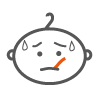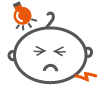Very young babies may not have a fever. Their temperature could be normal or low.
DO NOT wait for a rash.
If your baby or toddler is ill and getting worse, get medical help immediately.
A baby or toddler with meningitis or septicaemia can get a lot worse very quickly. Keep checking them.
Trust your instincts – Get medical help immediately.
Why are the under-5s at risk?
Babies and young children are particularly vulnerable to meningitis as they cannot easily fight infection because their immune system is not yet fully developed. The most common causes of meningitis are bacteria and viruses. Viral meningitis is rarely life-threatening, but can still make babies and young children very unwell. Most children will make a good recovery, but recovery can be slow. Bacterial meningitis can be fatal and needs rapid admission to hospital and urgent medical treatment. Whilst most children will make a good recovery, around 10% will die and some will be left with lifelong disabilities.
Find out more about the after-effects of meningitis and septicaemia.
Some bacteria that cause meningitis can also cause septicaemia (blood poisoning). The rash associated with meningitis is actually caused by septicaemia. You should never wait for a rash, it can be a late sign or may not appear at all. Learn more about the rash and glass test.
Download more information about meningitis in babies and children under 5.

 Fever, cold hands and feet
Fever, cold hands and feet
 Refusing food and vomiting
Refusing food and vomiting
 Fretful, dislike being handled
Fretful, dislike being handled
 Drowsy, floppy, unresponsive
Drowsy, floppy, unresponsive
 Rapid breathing or grunting
Rapid breathing or grunting

 Unusual cry, moaning
Unusual cry, moaning
 Tense, bulging fontanelle (soft spot)
Tense, bulging fontanelle (soft spot)
 Stiff neck, dislike bright lights
Stiff neck, dislike bright lights
 Convulsions/seizures
Convulsions/seizures